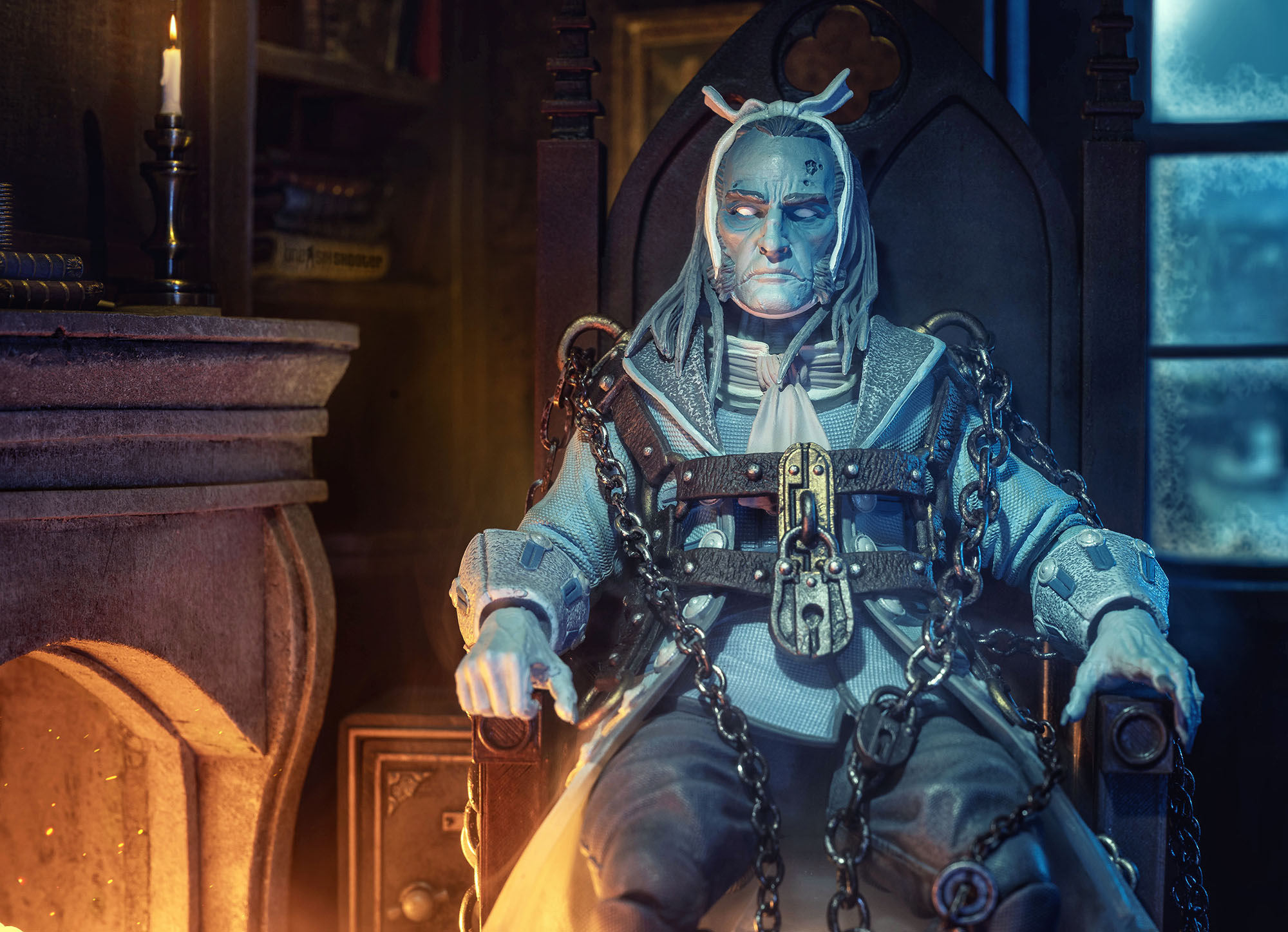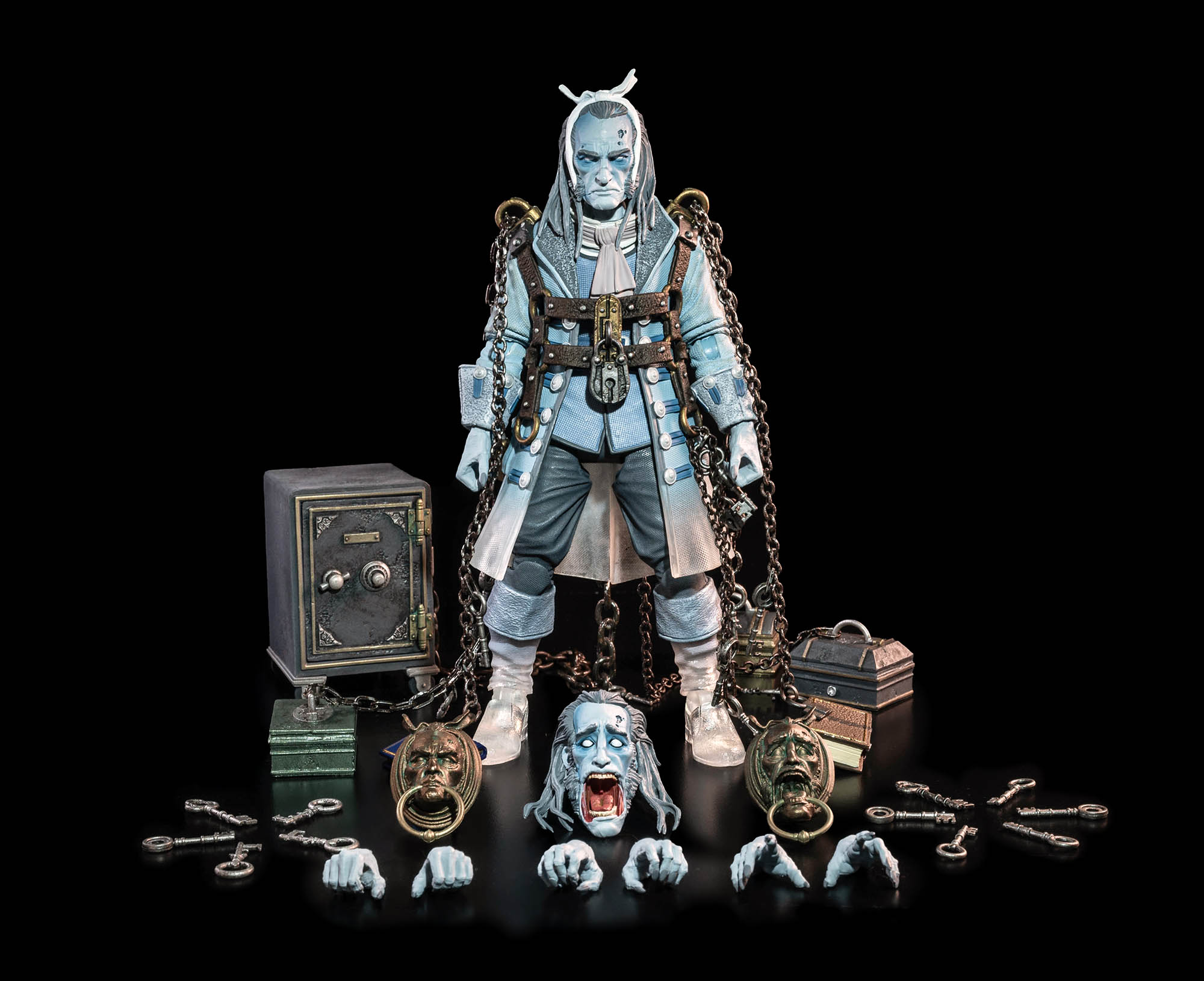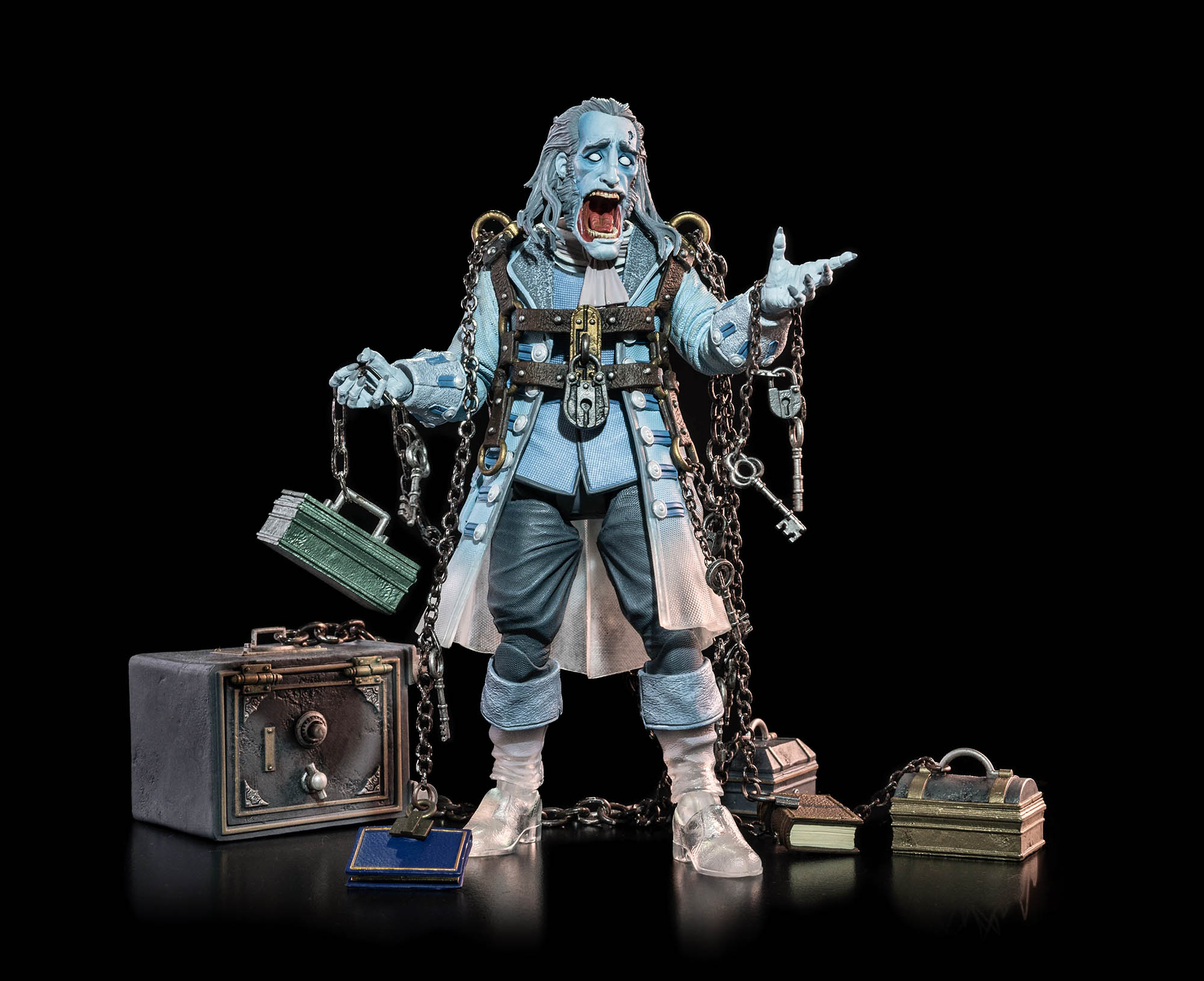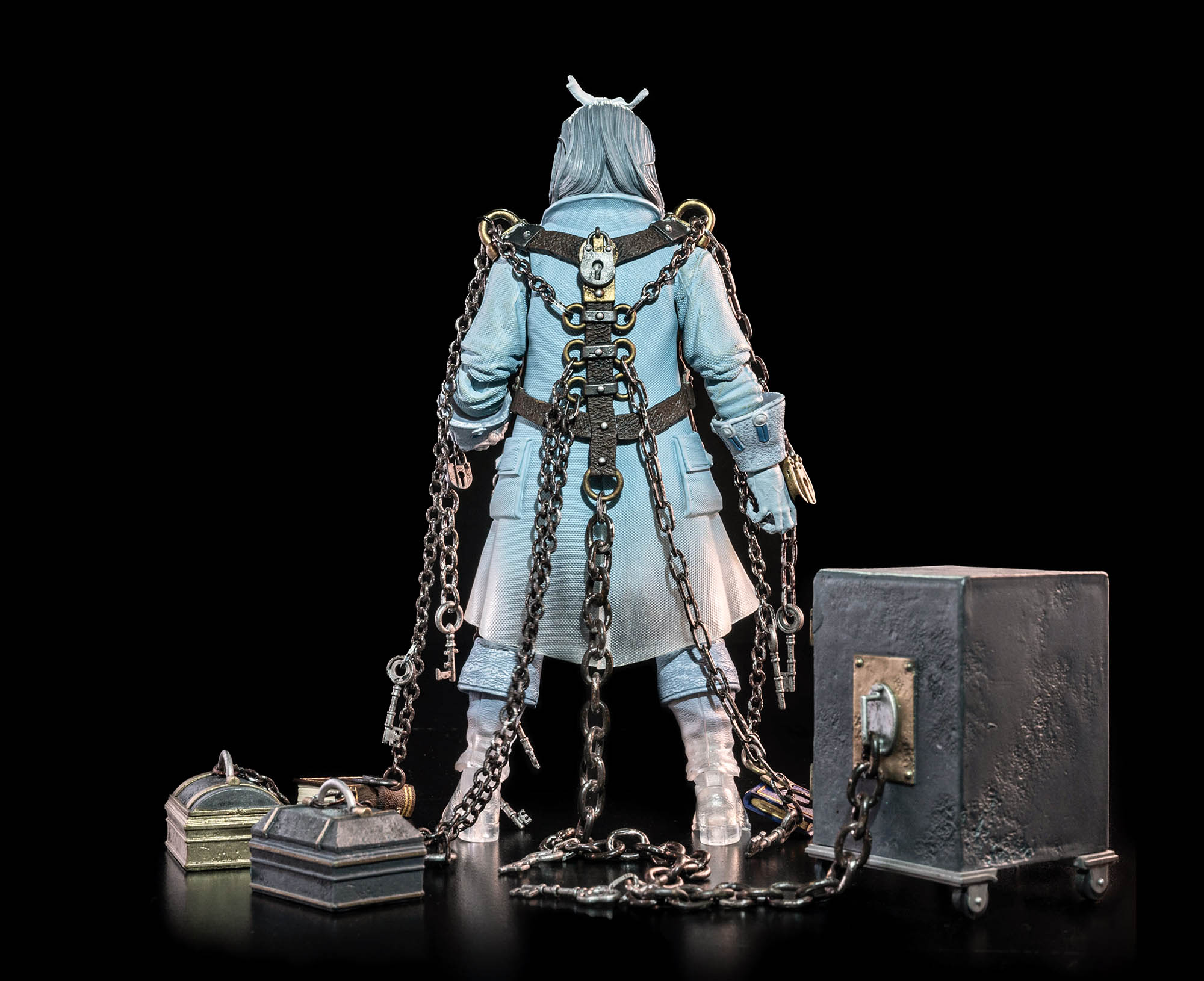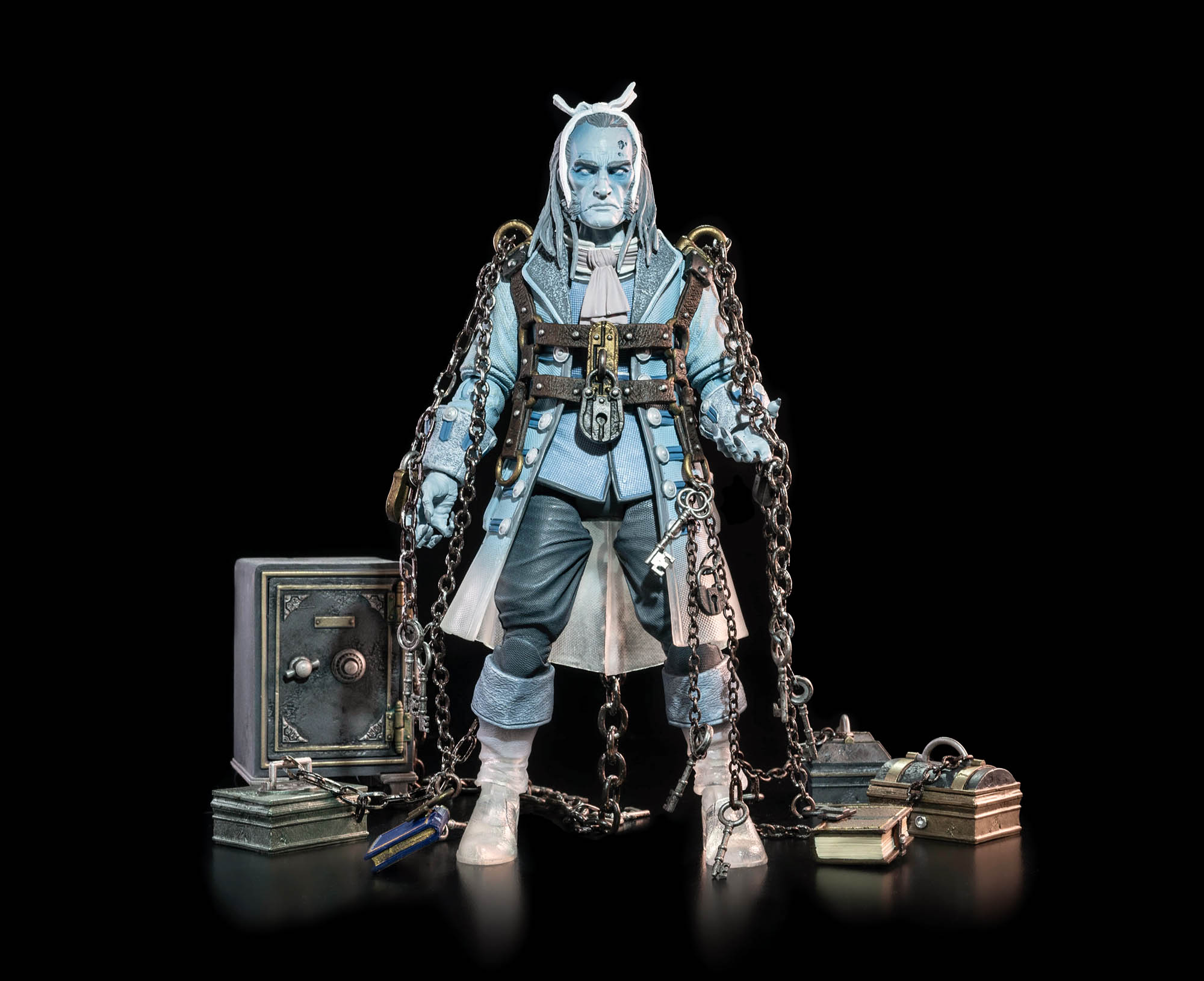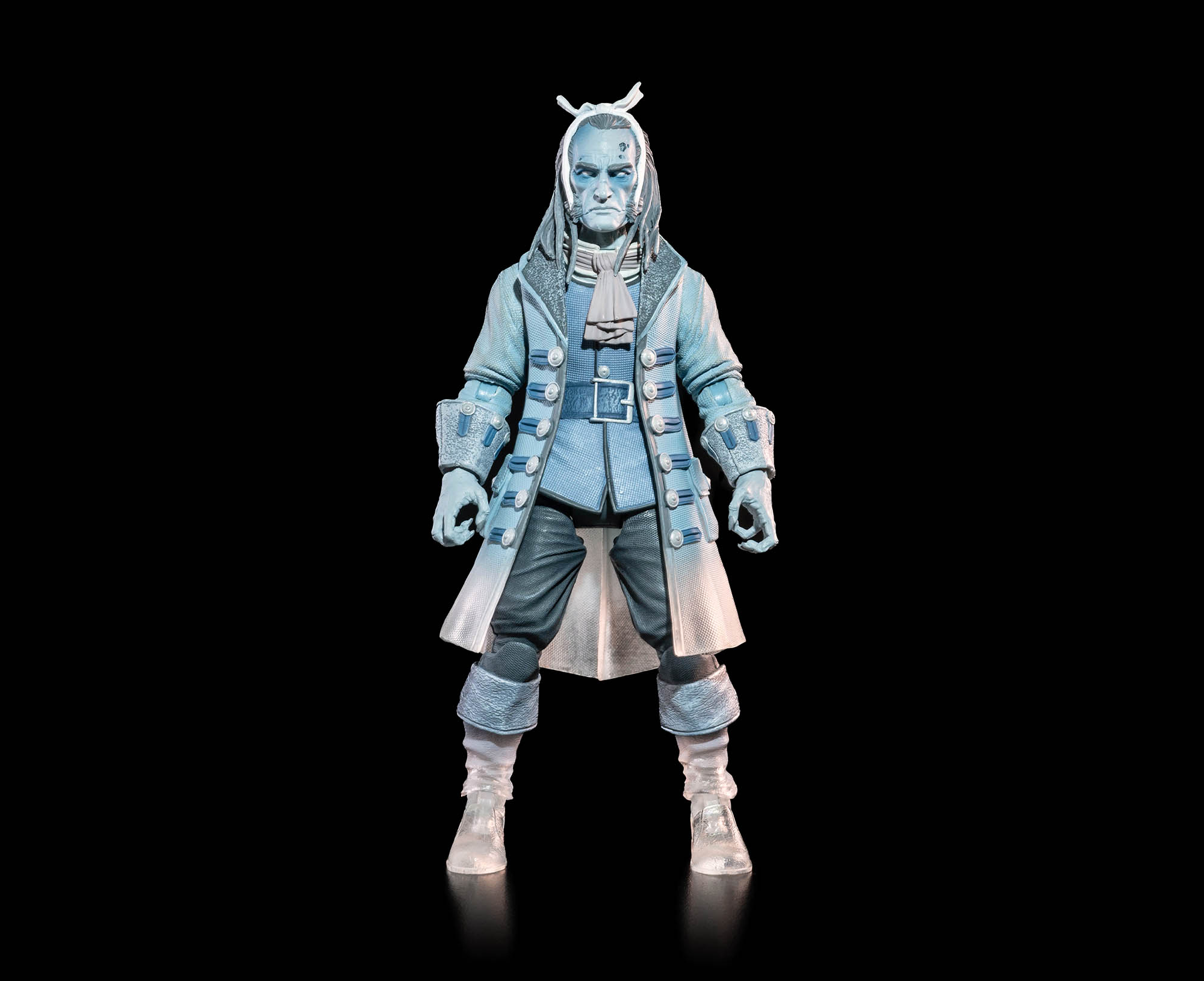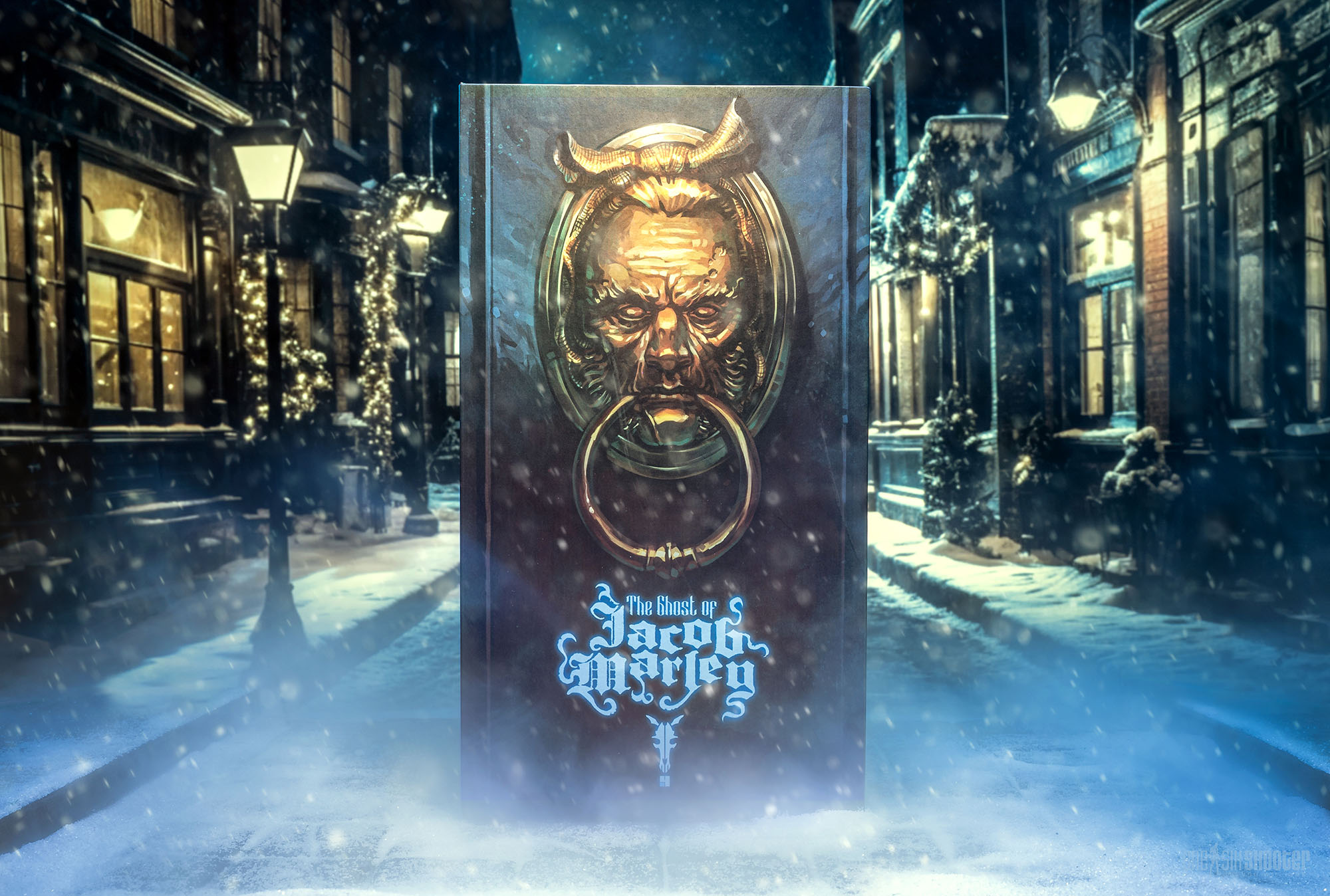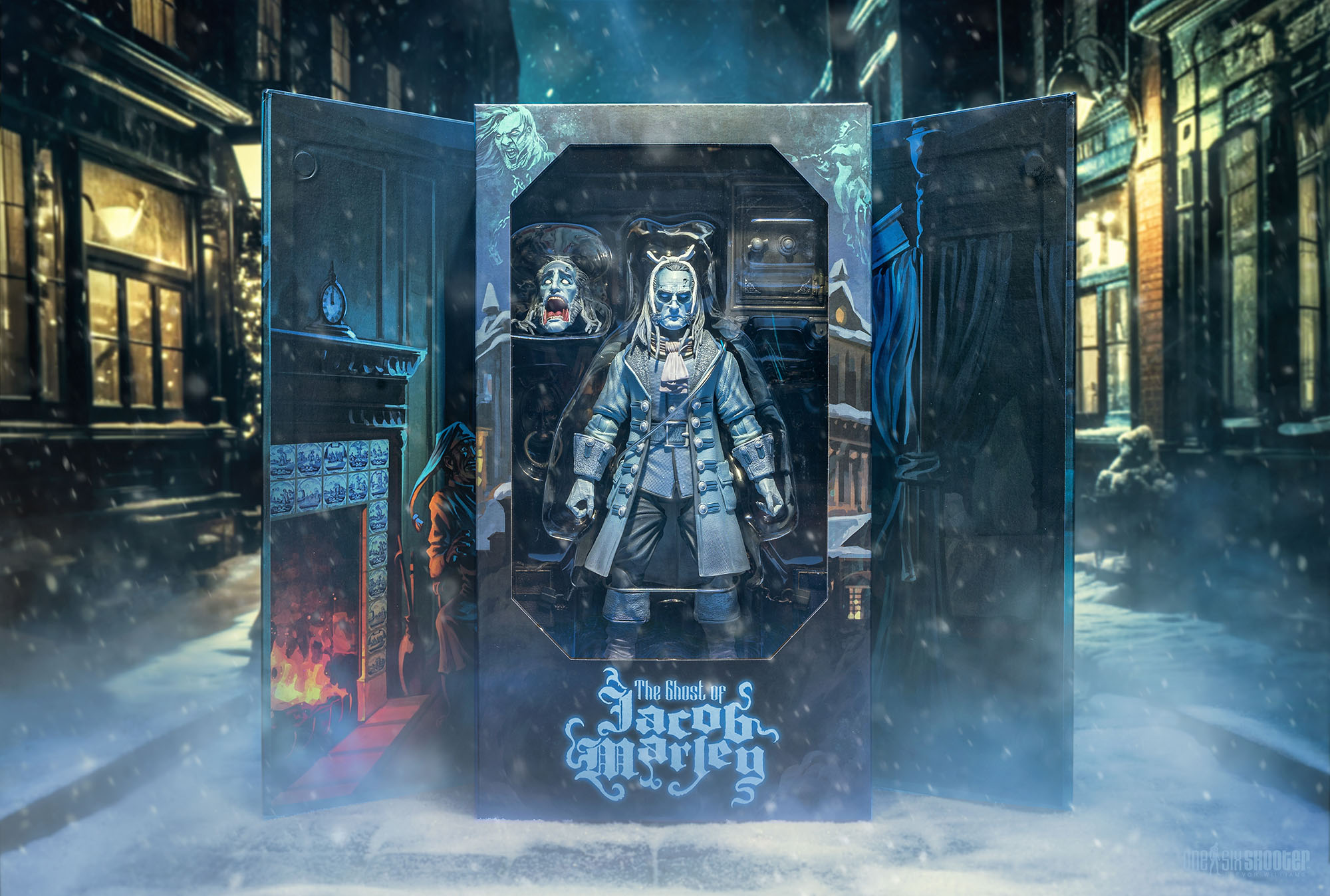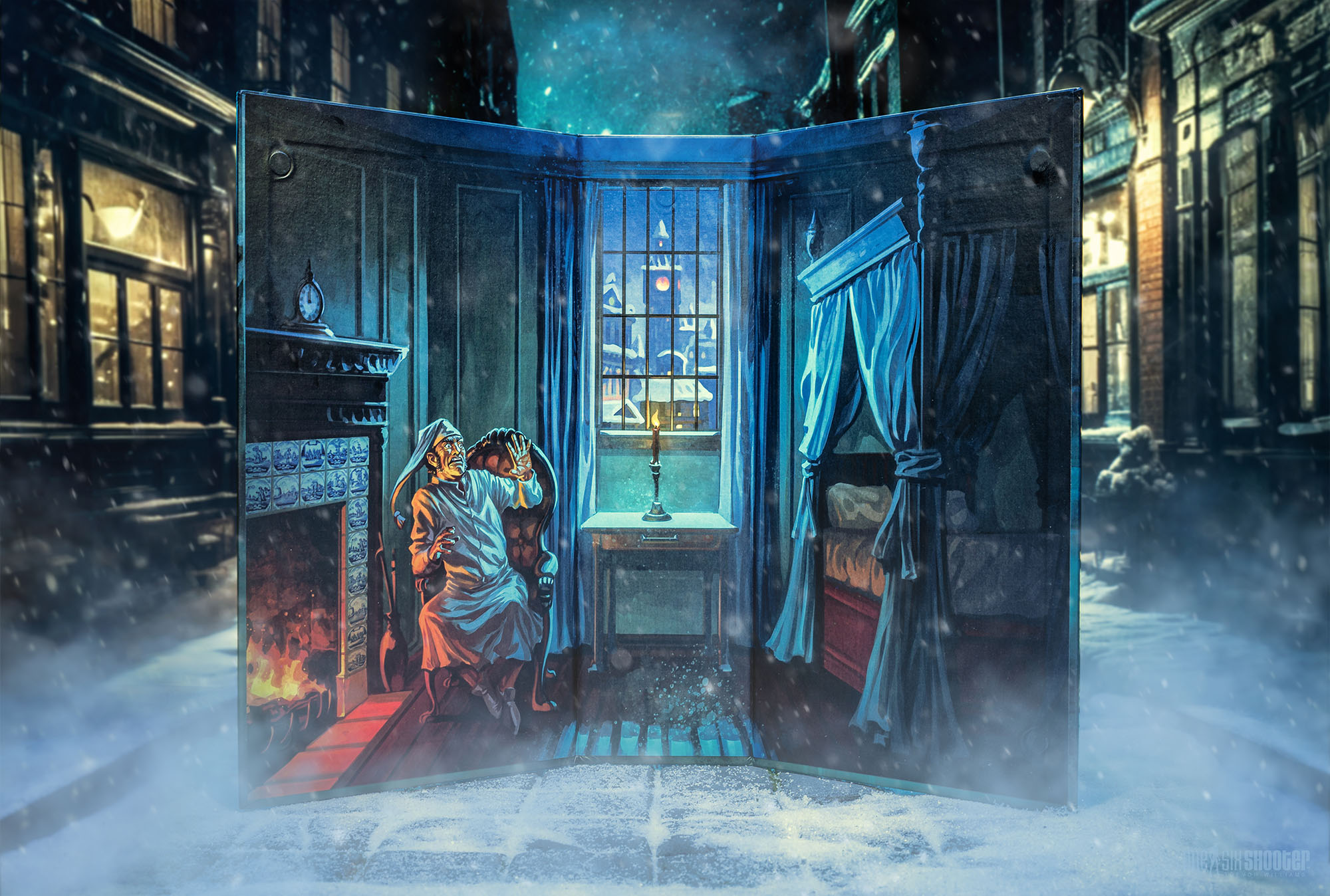Stave One: Marley’s Ghost
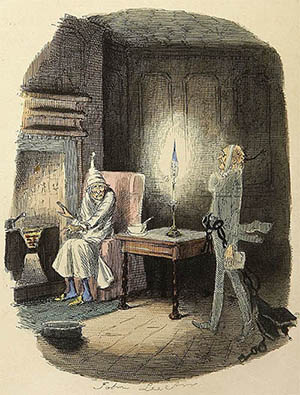
Cursed and eternally fettered, the specter of Jacob Marley wears the chains he forged in life. Each link is a sin that he committed against his fellow man. A reminder of opportunities lost, of chances to lift up and assist a person in need that he squandered in his blind greed. To many, the Ghost of Jacob Marley is a bit player in the story of A Christmas Carol. After all, he only really appears in one scene where he meets Scrooge in the old miser’s bed chambers. Yet, if we look deeper, we realize that none of the events of this story would have been possible without Jacob Marley.
When the Ghost of Marley appears to Scrooge, he explains that his old partner has “a chance and hope of escaping” his fate. He then goes on to mention that it is a chance and hope that he procured for Ebenezer himself! What deals did old Marley strike in the afterlife to allow his “sole friend” a chance at redemption? Was this “good man of business”, as Ebenezer described him, brokering deals with the spirits even as he dragged around the heavy burden of his own sinful life? Whatever the case may be, Scrooge’s second chance, and all of the events of this holiday tale, were because of the work of Jacob Marley.
When Scrooge finally awakens after a night amongst the spirits to realize he has indeed been given time so that he may change his ways, he exclaims “I will live in the Past, Present, and the Future! Oh Jacob Marley, Heaven and the Christmastime be praised for this! I say it on my knees, old Jacob, on my knees!”
So this man who was once a “tight-fisted hand at the grindstone” is saved, and he recognizes who is to thank for that second chance. Scrooge becomes as good a man as the old city knew – all because of the intervention and the dealings of his old partner.
Charles Dickens’ story does not tell what becomes of the Ghost of Jacob Marley. We do not learn if, perhaps, by saving the soul of Ebenezer Scrooge, he too earns his penance, or if he continues to travel the world dragging his chains behind him. Whatever his fate, it is safe to assume that he now understands that mankind is, and always should have been, his business - that Charity, Mercy, Forbearance, and Benevolence are all our business at this festive time of the year, and at all other times as well.
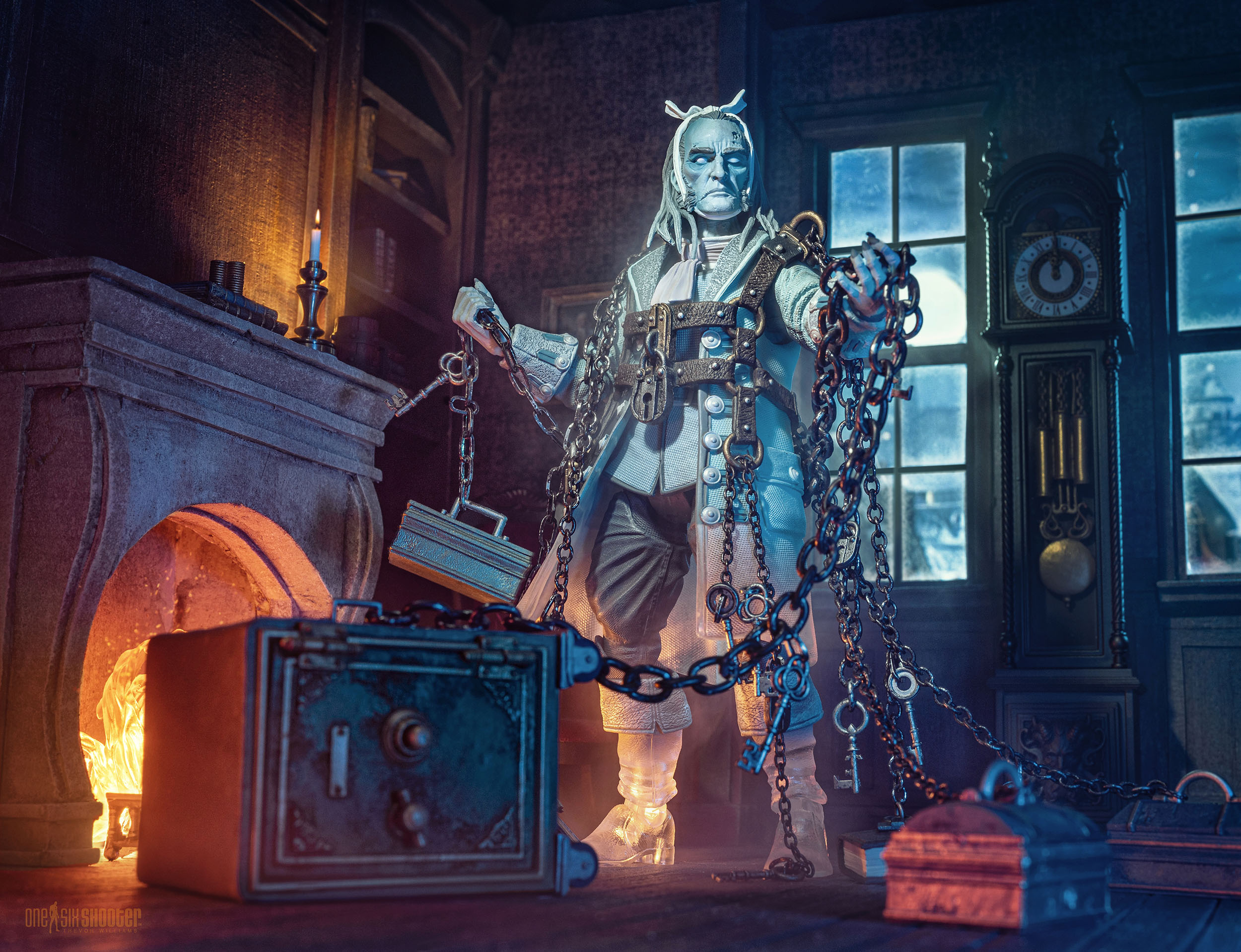
History
Charles Dickens first released the short story, “A Christmas Carol. In Prose. Being a Ghost Story of Christmas”, in 1843. This story was not Mr. Dickens first Christmas tale, but it is certainly his most popular. It sold out quickly, and by the end of 1844, thirteen editions of the tale had been printed!
“A Christmas Carol” was written during a time when the traditions of Christmas were being evaluated by the British people, and many historians and scholars have credited this tale, and Mr. Dickens, with helping to usher in a warm sense of favorability for the holiday season.
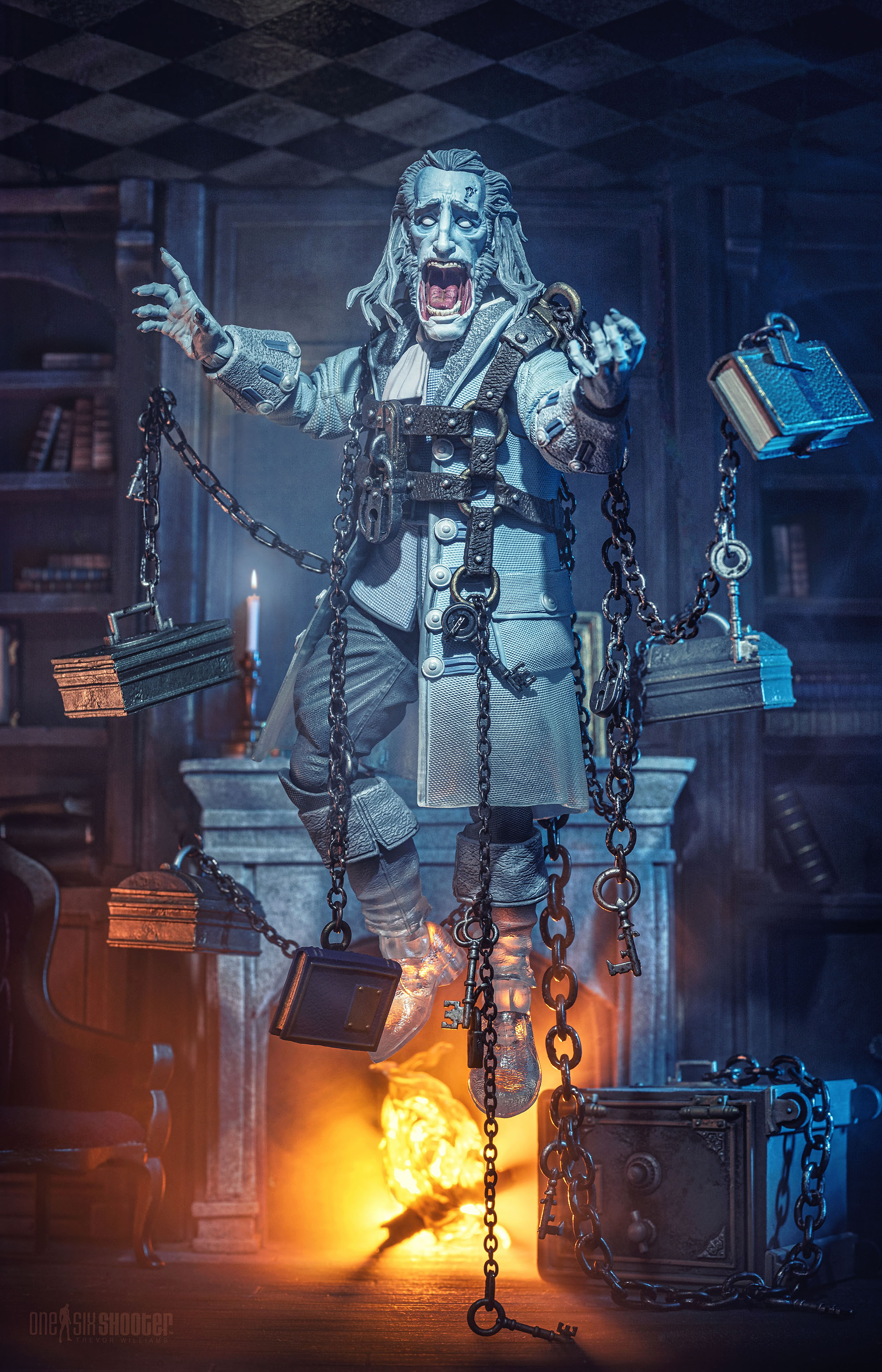
Charles Dickens’ story was widely praised by literary critics and beloved by fans in Europe and the United States. The publication encouraged Dickens to write some additional holiday tales, and also to embark on tours of Europe and the US to read this story. He began public readings of “A Christmas Carol” in 1849. These readings were so successful that he undertook 127 further performances, doing so until 1870, which was the year of his death.
Since its initial publication in 1843, “A Christmas Carol” has never been out of print. The beloved story has also gone beyond the confines of the printed page and inspired countless adaptations across various forms of media, some of which we will highlight next.
The Many Ghosts of Mr. Marley
A Christmas Carol is undoubtedly one of the most recognizable stories of the holiday season. Due to its popularity, this tale of redemption has been told many different ways over the years. Movies, stage performance, cartoons, books, comics, radio plays, and more have all embraced Dickens’ “Ghost Story of Christmas.” Some of these versions are faithful retellings of the original story, while others have put their own spin on the tale to create something which is both new and familiar. Of course, various versions of the story mean various takes on the Ghost of Marley. Here are a few notable versions (Editor’s note – there are literally hundreds of variations of this story across various forms of media. The text below is not meant to be a definitive listing of versions, but rather some specific ones which we have personally enjoyed and wish to share. For a more complete listing of versions of “A Christmas Carol”, see here):
In 1946, only .5% of US households had a television set, which meant that radio plays were a popular form of entertainment for families, and there is no one more recognized for radio versions of this story than Lionel Barrymore. Beginning in 1934, Lionel Barrymore was part of a Christmas day broadcast of “A Christmas Carol, a tradition he would continue every year on various programs until 1953, skipping the performance only twice during that span - once when his wife died in 1936 and again when he fell ill in 1938. Other notable names who have performed radio versions of this story over the years include Orsen Wells (who filled in for Barrymore in 1938), Alec Guinness, Vincent Price, and Tom Baker of Dr. Who fame. Versions of these radio plays can be found on YouTube today, including this one from 1939.
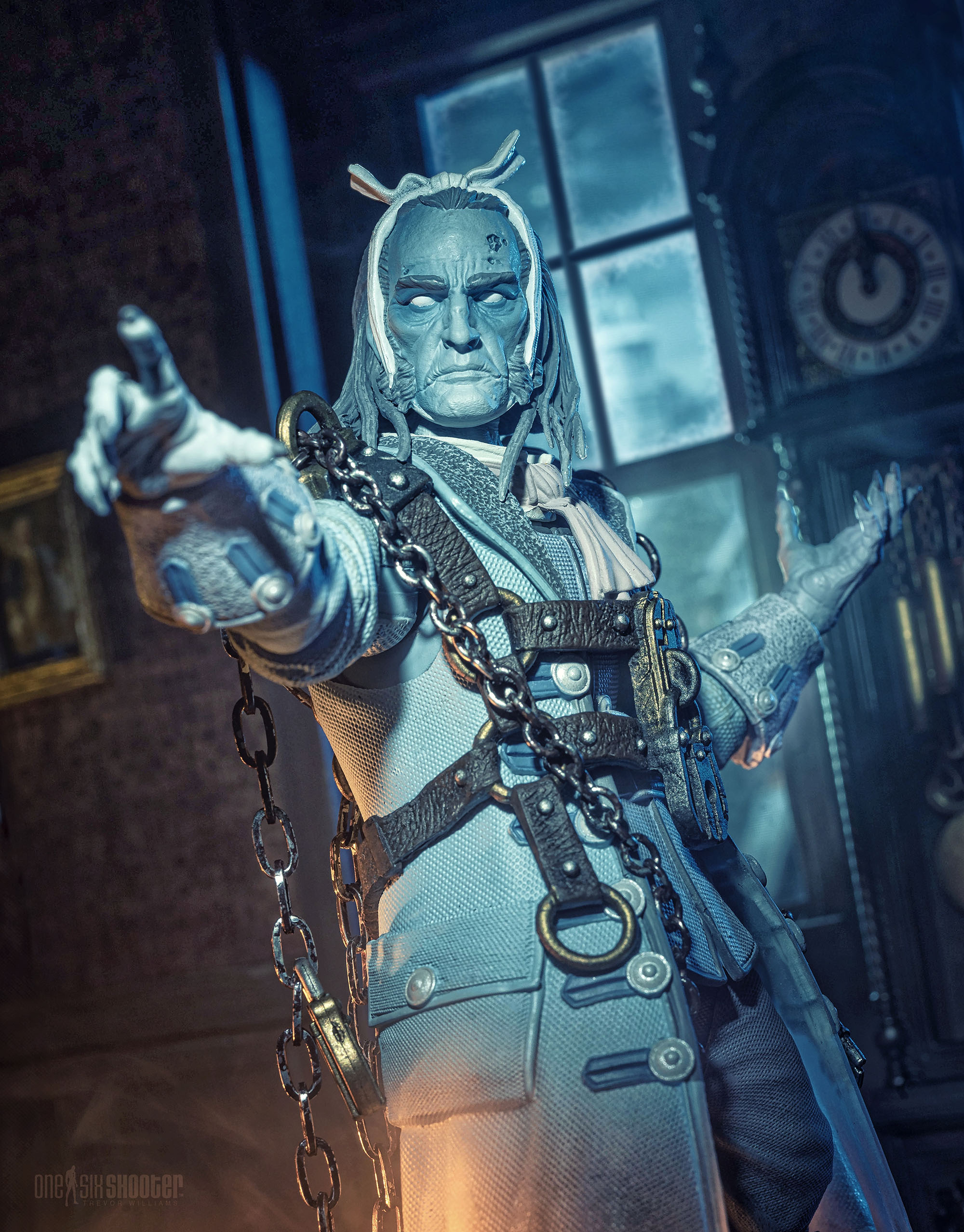
For many who celebrate the Christmas season, their first experience with Charles Dickens’ “A Christmas Carol” is most commonly a movie version of the story, oftentimes presented as a “holiday special” during the Christmas season. You can often tell a person’s age by which movie version of this story is their favorite. For some, the 1951 adaptation with Alastair Sim is the movie they remember. For others, the 1984 production with George C. Scott in the role of Scrooge is their preferred version of this tale. Beyond these two popular versions, there are dozens of other movies and television productions of the story, as well as animated versions with everyone from Mr. Magoo to Mickey Mouse to the Flintstones to Jim Carey taking on this tale.
In addition to faithful retellings of this story, there have also been a number of movies which drastically changed the tale or the way that it is told, usually for comedic effect. Some of these include Bill Murray’s “Scrooged”, Ryan Renolds and Will Ferrell’s team-up in “Spirited”, or even the Muppets’ take on the story in “A Muppets Christmas Carol” – complete with 2 Marleys played by the cantankerous duo of Waldorf and Statler!
Of course, this is a ghost story, and there have also been productions that explore the more chilling aspects of Dickens’ tale rather than looking for the humor and good cheer in the holiday classic. A 2019 mini-series starring Guy Pearce and Andy Serkis, with Stephen Graham as Jacob Marley, would fall firmly into this category of a darker take on this tale. It is also a version which expands Marley’s role, showing more of his and Scrooge’s relationship in life, and making him more of a player in the overall tale.
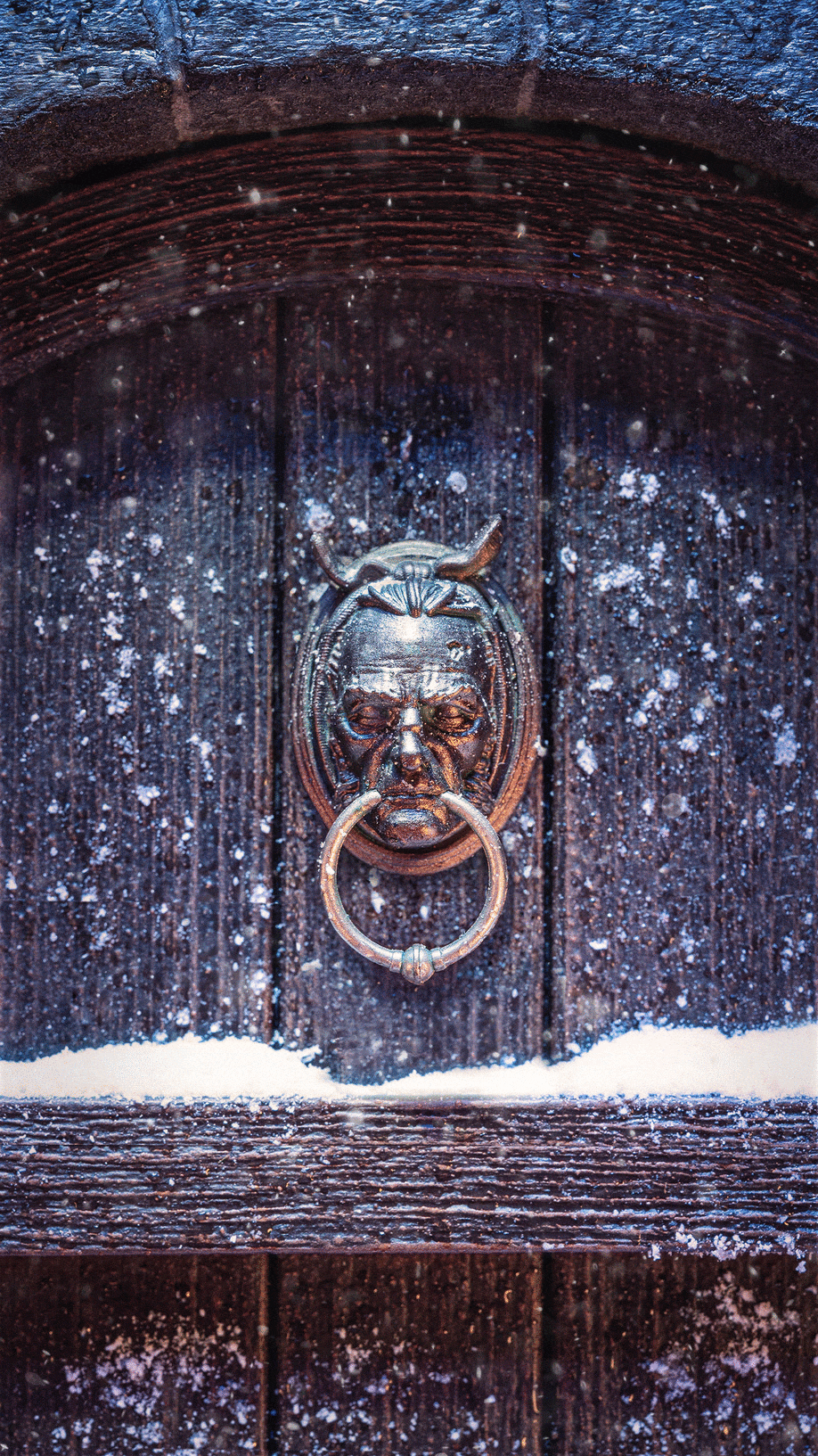
A Christmas Carol has also fueled numerous holiday episodes of TV shows including Betwitched, WKRP in Cincinnati, Family Ties, Star Trek: The Next Generation, Dr. Who, It’s Always Sunny in Philadelphia, and The Simpsons. This is just a small sample of the sitcoms and television shows which have used the general story and set-up of “A Christmas Carol” for the basis of a Christmas-themed episode.
A Christmas Carol is also popular as a stage performance, and many companies feature yearly productions of the play during the holiday season. One notable group of thespians doing exactly this is Trinity Repertory Company in Providence, Rhode Island. This company has performed this story for more than 45 years, changing the production each year. Some years the telling is indeed traditional, while other years it is dramatically reimagined. With race and gender-blind casting, part of the joy of this production each year is seeing what changes will be made and how the ghosts of the story, including Old Marley, will be presented.
Books are another medium which have told the story of Scrooge’s visit from the spirits in various ways. One notable book which actually focuses on Jacob Marley’s role in the tale is “Jacob T. Marley” by William Bennet. This short volume, which is written in the spirit of the original, places Marley at the center of the story, explaining how he and Scrooge first met and how Marley conditioned Scrooge to the miserly life he would eventually lead. Of course, as we have already mentioned in this article, the second chance at life that Scrooge received was due to Marley’s intervention, and this book tells that entire tale, including the events that happen before, during, and after “A Christmas Carol.” If you’ve ever wanted to know more about that chain-dragging ghost and the role he really played in this holiday drama, this book comes highly recommended!
Haunting Figura Obscura
After releasing Father Christmas for the 2022 holiday season, we decided to return to the spookier corners of the Yuletide season for 2023 and tackle Dickens’ most famous ghost. This was a project the entire team was excited for, with the iconic look of this spirit and his dragging chains being a perfect fit to join the ranks of the Figura Obscura!
There are certain elements of Marley’s Ghost which are generally consistent across portrayals of the character, such as the multitude of chains and the cloth tied around his head to keep his lower jaw in place. Those were elements that Eric Treadaway knew he wanted to include in this figure, with the chains being connected to various ledgers, cashboxes, and keys which are supported on the figure’s body by a harness that he wears.
Similar to the Monkey King, which was an earlier 2023 Figura Obscura release, The Ghost of Jacob Marley would be a mix of existing parts from the Legions library along with lots of new parts created for this release. While the upper arms and legs of the figure make use of the “fabric” limbs we already had in our library, brand new pieces were sculpted for the figure’s boots and a whole new jacket, with cuffs that replaced the “gauntlets” typically found on a Legion’s figure, was developed. A new chest plate and skirt piece were also sculpted along with those aforementioned cash boxes, ledgers, locks, keys, and even a full safe that this cursed spirit drags around!
One fun note on these new parts – the boots sculpted for Marley ended up being used on the Kurnn Ray figure from Cosmic Legions. So the first time that people got to see these boots, which is a part that Mythic Legions collectors have requested for some time, was actually on a Cosmic figure, yet they were actually developed thanks to Figura Obscura! This is a perfect example of how these three lines from Four Horsemen Studios can help feed each other and our ever-expanding library of parts.
Of course, in addition to all these new parts, the Ghost of Jacob Marley also needed some new heads, and this figure includes a pair of portraits that can be used to change up the character’s look. One of the heads shows Marley with a stern, humorless expression, his jaw held in place by that cloth that is tied around his head. The other head removes this cloth, and Marley’s jaw hangs low with a chillingly mournful expression.
There are a number of other fun things included with this figure, like the doorknockers featuring Marley’s face, or the key that he drags around that looks quite familiar. Oh, and what is that in his safe? You’ll have to crack it open to see for yourself!
The colors on the Ghost of Jacob Marley were chosen to represent how he would appear to Scrooge as he first begins to manifest. The lower part of the Ghost is barely there, and the upper body’s colors are muted and washed away, showing that the color and the life has drained out of this man who is doomed to walk the Earth to atone for his sins.
The Art of Jacob Marley
As with all Figura Obscura releases, brand new artwork was created by Nate Baertsch for this new character. That artwork is featured on the package for The Ghost of Jacob Marley, as well as in a mini-comic that is included with each of these figures. We introduced the idea of a Figura Obscura mini-comic with the “Masque of the Red Death” release, and we liked doing that one so much (and it was so well received) that we decided to create one for Marley as well! This particular comic is the first chapter of the story, or “Stave 1” according to the book. This chapter is the one that begins the story and introduces Marley’s Ghost as he visits Scrooge while also setting the stage for the rest of the ghostly visits in the story and his old partner’s eventual redemption. That chapter is presented in full in the included mini-comic alongside Nate’s artwork. You can see an example of one of the pages below.

A few more notes about the artwork chosen for this package – as the project began, we decided to only feature scenes from the book's first chapter on the box, rather than show images from the story as a whole. After all, if we showed all the scenes and characters from "A Christmas Carol" here, we wouldn’t have anything left should we decide to revisit this story for future Figura Obscura releases!
The opening Stave of “A Christmas Carol” is fairly bleak, and the resulting package artwork reflects that. The front of the box includes the iconic image of Marley’s face as a doorknocker, while the inside panel shows Scrooge in his bedchamber, a horrified reaction upon his face as he is visited by the spirit of his old partner.
One of the coolest and most fun aspects of this new box art are the other spirits which haunt the sides of the main package. These spirits were meant to recreate the scene where Marley’s Ghost beckons Scrooge to a window so that he may show him other cursed spectres who walk the Earth as he does. When planning out the look of these spirits, Nate and Jeremy came up with the idea to use the faces of some fellow members of the studio as those ghosts! Only Eric Treadaway was given a heads up that this was being done, so when the final art was delivered and Chris and George saw their faces as ghosts, you can imagine their surprise and delight! You can see these “ghosts of the studio” below on another one of the mini-comic pages. Can you identify the other team members who appear as Earthbound spirits set in the world of Charles Dickens?
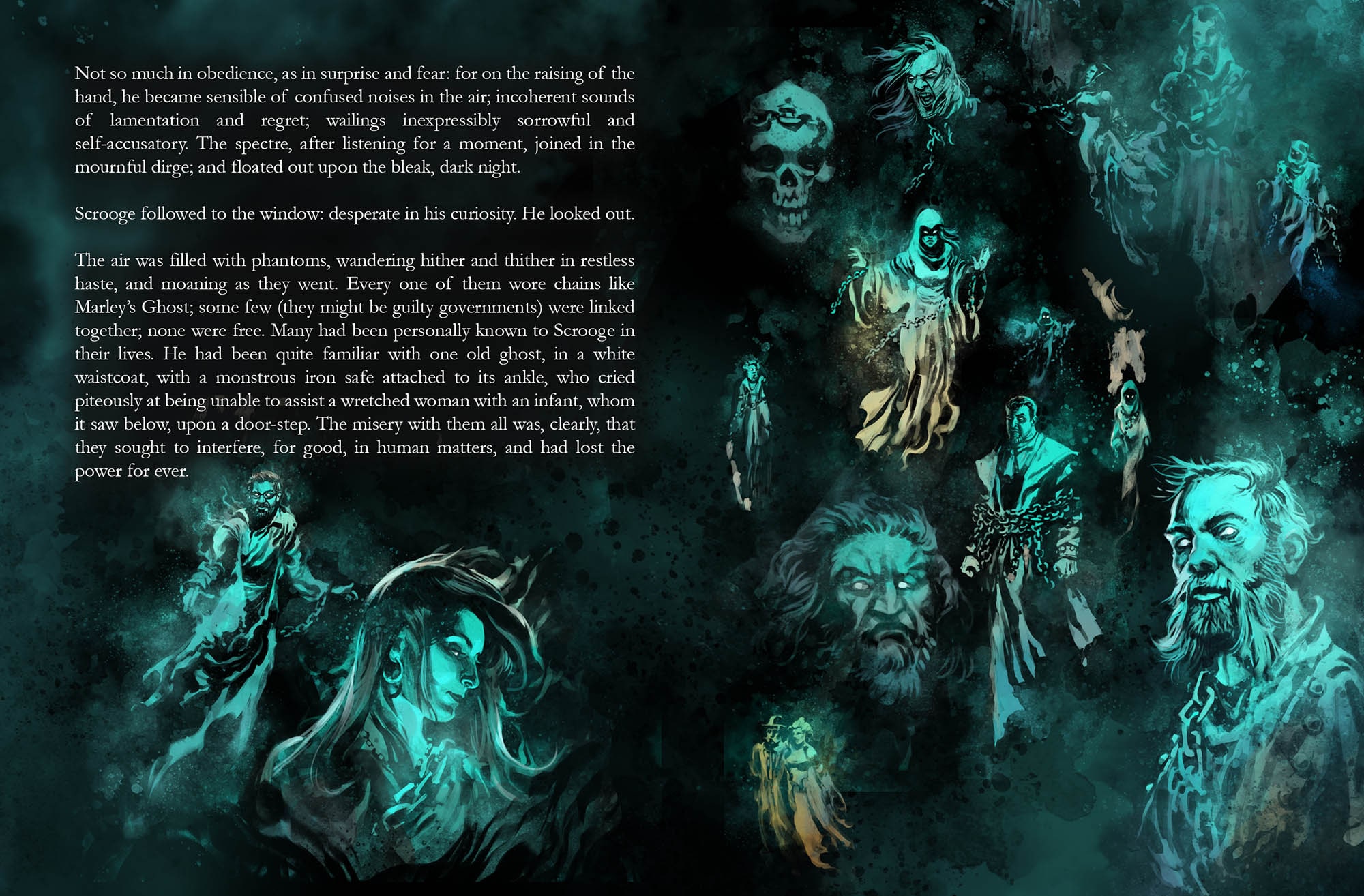
In addition to the packaging itself and the included mini-comic, the new art created for this release was also used on pins, mugs, holiday cards, and t-shirts. Examples of these items can be seen in the image below.

Haunted Blue
In early 2024, a new version of the Ghost of Jacob Marley was announced as part of our "2024 Retailer Appreciation Wave." This wave, which would only be offered by Four Horsemen Studios' retailer partners, included a "Haunted Blue" version of Dickens' most famous ghost. The decision to repaint this figure in a more cartoonish color scheme reminiscent of the happy haunts seen at Disney's Haunted Mansion attraction seemed like a fun choice. After all, the many representations of old Marley over the years had certainly helped to inspire some of the spirits of the Haunted Mansion, so it was approproate to allow those spirits to in turn inspire this new version of Jacob Marley. This approach also follows what we did for our Headless Horseman figure, with the first version being more of a literary take on the character, and the retailer version the more cartoonish version.
The retailer version of the Ghost of Jacob Marley comes with all the pieces from the first release, including the surprises "iron mask" head that was hidden in Marley's safe. You can see a photo of the "Haunted Blue" version of Marley below:
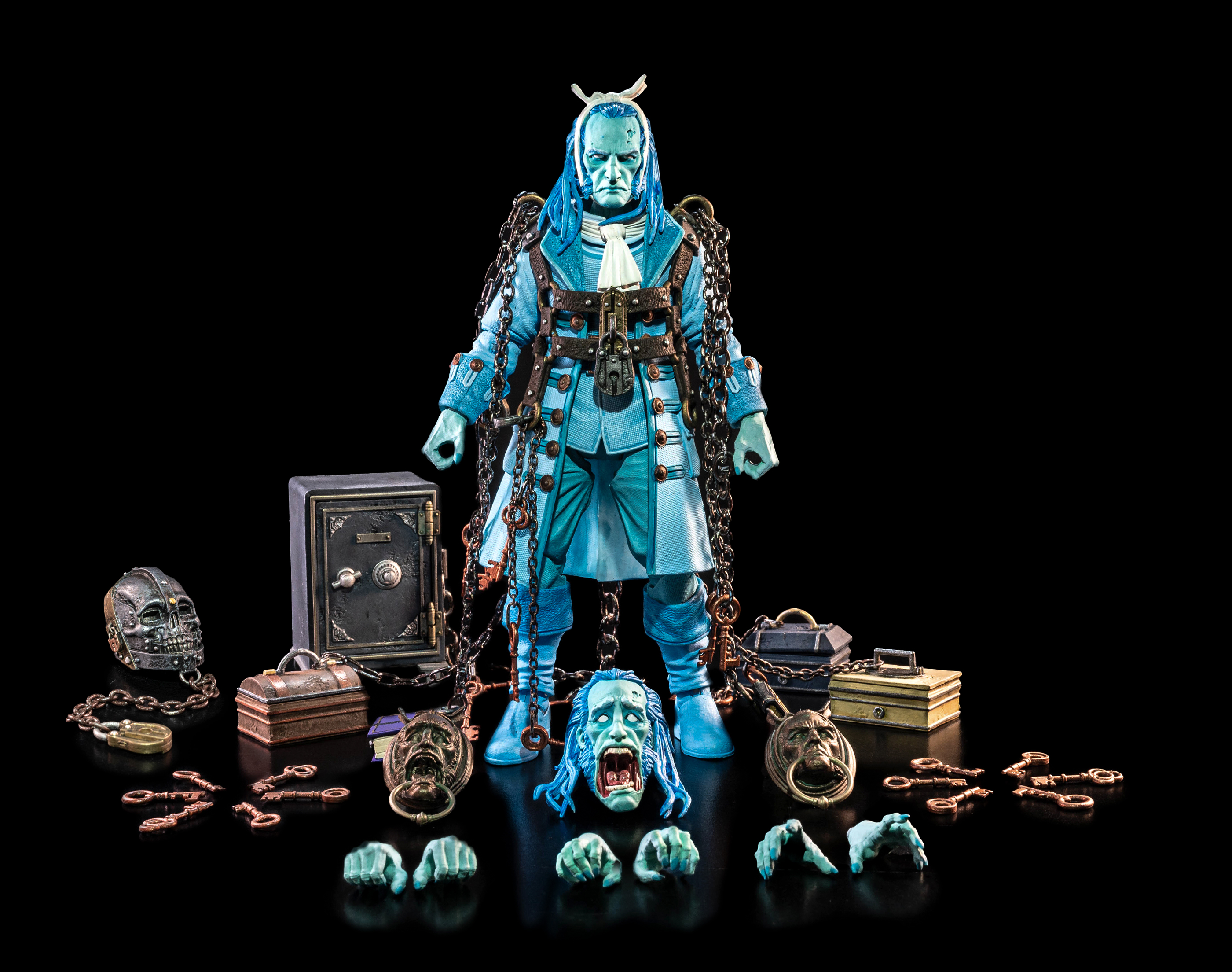
Past, Present, Future
Figura Obscura has become an important and exciting part of Four Horsemen Studios’ release calendar each year. The Ghost of Jacob Marley is the third Figura Obscura released for 2023 and the sixth character overall, but he is certainly not the last character we will see make their way to the halls of the Figura Obscura. Who waits next in the shadows, ready to be beckoned forth by the Four Horsemen? That is a tale for the future, and one which must wait for another day.
